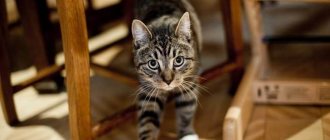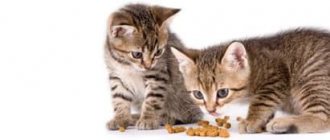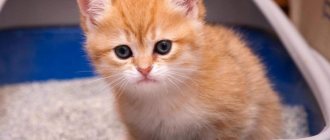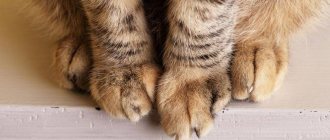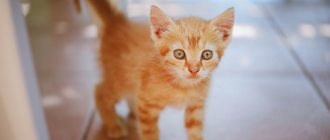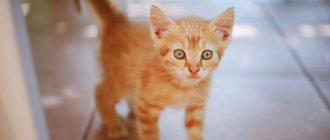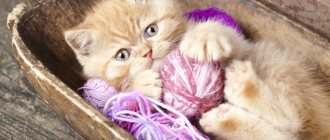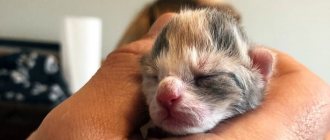26.05.2020
The mother cat closely monitors the toilet of a newborn kitten, carefully licking it and keeping it clean. With the arrival of a small kitten in the house, the responsibility for monitoring the proper functioning of its digestive system falls on the owner.
How often kittens go to the litter box determines their future health. To help the pet develop healthy, it is useful for the owner to know why bowel problems occur, how many times month-old kittens should go to the toilet, and what to do if the kitten does not go to the toilet for a long time.
Tray for newborn kittens
A mother cat helps a newborn kitten go to the toilet in the first three weeks of its life. A cat, licking its cubs, not only cleanses them of dirt and foreign odors, but also stimulates blood circulation in the digestive organs.
Thanks to this massage, it is easier for the kitten to get rid of gases and empty itself. The cat licks off all the dirt, leaving the appearance that the kitten does not go to the toilet at all.
"Attention! In order for the kitten to get into the tray without problems, it is important that the kitten tray has low sides.”
If for some reason the cat does not know how to provide proper care to the kitten, you can help him yourself. In a situation where the kitten does not want to go to bed for several days, and in order to eliminate the consequences of a bloated abdomen from gases, certain actions need to be taken.
Using a soft brush or cotton wool moistened with warm water, gently massage the kitten's belly in a clockwise direction in a circular motion. Additionally, a soft massage is performed in the direction from head to tail, with longitudinal movements.
Tray for one-month-old kittens
Upon reaching three weeks of age, the kitten’s intestines are already sufficiently populated with beneficial microflora, formed and ready to accept adult food. At this age, the kitten still feeds on mother’s milk with gradual complementary feeding in the form of liquid kitten food or creamy food. This food does not injure the intestines and does not require too thorough chewing.
At three weeks of age, a kitten should go to the toilet approximately 3 to 6 times daily. Normally, a kitten's feces should be mushy, uniform and thick. They should not contain impurities in the form of mucus or undigested food elements. The kitten itself should be cheerful, and its belly should be soft to the touch and painless. An unfavorable sign for the owner is kitten feces that are too dry or too runny.
If the kitten does not have stool for 3 or 4 days, you need to carefully analyze the pet’s diet. Abdominal massage, microenemas, and a small amount of vegetable oil can help.
When does a kitten poop on its own?
Once they are about 4 weeks old, they will generally have no problems defecating or urinating, and in all likelihood, they will have already mastered the technique of pooping.
Despite this, you should still strive to constantly monitor how much food they consume and how regularly you help the kitten cope with itself.
If he or she still requires you to help with elimination functions before four weeks of age; then you will need to bring your kitten to a professional veterinarian for examination as soon as possible. There may be something wrong with their internal system. In this case, make sure you watch out for the worst possibilities and stay vigilant.
If the kitten does not produce feces after feeding, you need to find out the reason for this behavior. After 3 days of feeding solid food and your kitten still not pooping, you should call your veterinarian immediately. When the kitten takes the formula, the feces may be pliable. Complete solid poop will not appear until your kitten is on solid food.
Article by: Luna Tran My name is Luna, I am a big cat lover and the owner of three beautiful cats. Until now, I have had many cats, and I have devoted many years to raising and caring for them. In this blog I want to share my knowledge and experience about cats.
Toilet for adult kittens
The kitten is transferred to adult food from the age of 1 to 3 months. In general, coca feces become more shaped. The number of visits to the toilet, as well as the consistency of feces, depend on the type of food the kitten eats. When eating food with a lot of fiber, the number of bowel movements will be greater than with high-protein food.
A grown kitten goes to the toilet almost every day, and its feces should be free of blood, mucus, and undigested food. The owner should be wary of the fact that the pet often goes to the toilet with very liquid feces.
What to do if there are deviations
Violation of the frequency of toilet visits by a small kitten is usually associated with stressful situations. Such factors disappear by themselves when the animal goes through an adaptation period. The situation is more complicated when urination is impaired due to health problems. In this case, the kitten can either walk too often or too rarely.
Frequent urination
If a kitten pees frequently, then most likely he has developed cystitis, a disease of the urinary organs, or urolithiasis. The baby will often run up to the tray, but the volume of urine will be catastrophically small. Sometimes there is blood in the urine.
Frequent urges can be caused by drinking too much in hot weather, as well as diabetes. Urinary incontinence is accompanied by a large amount of fluid released and no bleeding. The same signs are characteristic of marking territory.
Cystitis most often occurs in adult kittens. The reasons may be:
- drafts;
- sand in the kidneys;
- impaired metabolism;
- mineral imbalance;
- sexual infections;
- predominance of dry food, lack of liquid and proteins.
Deviations from the norm should be studied and treated in veterinary clinics
Cats of any age can get urolithiasis. Signs of the disease are:
- unsuccessful visit to the tray;
- a tiny amount of urine;
- presence of blood in the urine;
- vomiting and high fever;
- lethargy and apathy.
There are cat breeds that are genetically predisposed to this disease. Among them are Scottish Fold, Persian and Siamese breeds.
Also, frequent urination can be associated with diabetes, stress or enuresis. In any case, assistance to the pet must be qualified and timely. If there is the slightest sign of a pathological condition, you should immediately contact a veterinarian. He will prescribe a number of diagnostic measures and adequate treatment.
A kitten who pees frequently will undergo the following tests:
- blood biochemistry;
- Analysis of urine;
- X-ray;
- comparison of the amount of urine and drink;
- Ultrasound;
- hormone test;
- determination of acetone levels and acid-base balance.
These types of studies will help to identify the nature of the disease of the genitourinary system, make a diagnosis and decide on treatment.
In addition to adequate therapy, it is important to carry out a number of preventive measures for the full functioning of the genitourinary system. Regular medical examinations, proper diet, physical activity, and the optimal amount of drinking will ensure normal urination and healthy urinary tract of the kitten.
Too infrequent visits to the litter box
Rare urination is just as dangerous to a kitten's health as frequent urination. In such situations, the main cause is pathological processes, both in the genitourinary system and in the body as a whole. Almost 75% of cases of insufficient urine flow or insufficient discharge occur due to cystitis. Lack of proper treatment will invariably lead to a condition such as acute urinary retention.
Having such a diagnosis, a kitten may not walk for more than a day. This is a dangerous phenomenon that often ends in death. The bladder becomes full and bursts. Urine enters the abdominal cavity, which can lead to intoxication of the body and death of the pet.
Kittens need to be fed crushed food.
The pathology most often occurs in male kittens. For females, such a disease is not typical, although it is also sometimes detected. The main cause of the disease is stones that block the urinary tract. Experts identify other factors:
- blockage of the urethra by a blood or mucus clot. Occurs against the background of trauma to the genital organ or an infectious disease, in particular the bladder;
- abnormal kidney function. With renal dysfunction, the kitten’s body can no longer excrete urine even in minimal volumes. The cause may be a malignant tumor or perforation of the kidney;
- spinal injury or infectious disease affecting the spinal cord. The absence of a nervous connection between the genitourinary organs and the spinal cord leads to disruption of their functioning and the cessation of urination of the animal.
Urinary retention of any stage requires urgent treatment. In the clinic, a kitten may be prescribed the following procedures:
- catheterization using a special catheter that is inserted into the urethra. This will help empty your bladder;
- surgical intervention. Prescribed in case of ineffectiveness of repeated catheterization.
To prevent advanced cases of impaired urination, the owner of kittens must take preventive measures daily:
- animals must receive anti-infective vaccinations on a schedule;
- avoid hypothermia;
- provide access to an unlimited amount of fresh and clean water;
- the diet must comply with the kitten’s nutritional rules according to its age;
- an active lifestyle and outdoor games will also be beneficial.
For any pathological conditions or deviations from the norm, it is prohibited to prescribe medications yourself. Kittens must be treated by a veterinarian. He will also tell you how many times a kitten should poop and pee per day. This will keep your little pet healthy and alive.
How often should a kitten pee?
When answering the question of how often a kitten should pee, you need to take into account the amount of liquid it consumes. The amount of urine should be equal to the volume of liquid drunk. A very small kitten has a small bladder capacity and will pee more frequently than an adult.
On average, a kitten goes to the toilet up to 10 times a day. An older kitten will have to go to the toilet up to 5 times a day. An adult cat goes small no more than 3-4 times a day.
"Attention! If your pet's diet is high in fiber, the number of trips to the toilet may increase."
The process of urination itself is normal and should not cause discomfort to the kitten. It is worth paying attention to the quality and color of urine, its transparency, the presence of impurities in the form of blood and mucus.
Preparations for normalizing stool and treating constipation
According to their action, laxatives can be divided into several groups:
- Irritating laxatives – tablets, suppositories, drops. They irritate intestinal receptors and cause increased peristalsis.
- Increasing the volume of intestinal contents are ballast substances (bran, flax seed).
- Helping to soften the contents - liquid paraffin, petroleum jelly.
- Osmotic agents increase the fluid content in the intestinal lumen (lactulose, lactitol, macrogol/polyethylene glycol).
All of the above groups of drugs have strengths and weaknesses (You can read more about the types of laxatives, their advantages and disadvantages in the article “How to choose the right laxative?”). However, to solve the problem, an integrated approach to treatment will give the best result. A combination of physical activity, proper diet, drinking enough water and the use of laxatives allows you to restore regular bowel movements and restore the joy of life3. To normalize stool and treat constipation, the optimal choice would be osmotic agents8, in particular the drug Duphalac®.
Why does a kitten have problems with stool?
Stress has affected bowel function. A kitten may refuse to go to the toilet due to worries about moving to a new home, changing its owner, or being separated from its mother. To help the kitten get comfortable in a new place, you should protect it from noise, sudden movements, and games with children. The kitten itself must begin to play in the new territory, run, and go to the toilet. If the kitten does not defecate within 5 days, you should contact a veterinarian.
Due to poor nutrition, the functioning of the digestive system is disrupted. In a new home, the kitten must adhere to the diet of its old owners for some time, with a gradual addition of new cat food. When choosing ready-made food, you should pay attention to special diets for kittens.
If a kitten does not walk for more than 5 days, even having gotten used to a new place and food, then constipation may be the cause of problems with stool. By feeling your pet's abdomen, you can determine the presence of bloating, which usually accompanies constipation.
A sign of constipation is the painful process of defecation in your pet. Signs of constipation are also: sitting on the tray for a long time, plaintive meowing.
Benefits of Duphalac®
Duphalac® has a dual effect: it gently and comfortably cleanses the intestines, providing a laxative effect, and due to its prebiotic effect, the drug allows you to restore the balance of intestinal microflora and has a long-term effect in normalizing stool6,10.
Duphalac® has a favorable safety profile and is suitable for people of any age, as well as children from the first days of life, pregnant and lactating women2,10.
Duphalac® is the optimal remedy for chronic constipation and irregular bowel movements, since when it is taken, the intestines do not stop working on their own, and it can be used for as long as necessary9,10.
RUS2132194 from 07/21/2020
Co-author of articles, editor - Shimbaretsky Georgy Alekseevich.
How to deal with constipation in a kitten yourself
If your pet feels well enough, you can try to cope with your kitten’s constipation yourself with the help of:
- Oils: if the kitten does not go to the toilet for several days, you can give simple vegetable oil in an amount of no more than half a teaspoon per day. You can introduce it into the mouth using an ordinary syringe without a needle, slowly so that the kitten does not choke. Vaseline oil is also effective for constipation. It can be added at each feeding, 0.5 ml, in combination with a gentle therapeutic massage.
- Soap: you need to make a small peg of baby soap and insert it into the anus. Before administration, the soap should be moistened in warm water. It is more convenient to carry out this action while the pet is sleeping. After it, within a few hours, the kitten should successfully go to the toilet for the most part.
- Medications: You should consult your veterinarian about the appropriateness and correct use of medications.
- Enema: the enema procedure at home is carried out only in full confidence that it is harmless to the kitten. This procedure is relatively safe only if the cause of constipation is precisely inappropriate nutrition, and not intestinal obstruction or volvulus. There is a list of conditions for which an enema is strictly contraindicated: inflammatory processes in the intestines, bleeding, rectal prolapse, acute pathologies of the abdominal organs, inflammatory processes in the intestines.
Treatment and prevention
It is important to prevent irregular bowel movements from becoming constipated, but to take control of the situation in time and help the intestines restore normal functioning. Don't wait for the problem to get worse. We need to act.
The main goal is to get rid of the disturbing discomfort, restore the normal rate of bowel movements and return stool without difficulty.
The result can be achieved by changing your lifestyle and eating habits. It is necessary to include foods rich in fiber in your daily diet. It is also important to monitor your water balance and consume at least 1.5 - 2.5 liters of fluid per day. It is recommended to eat more vegetables, fruits, berries, food bran, dried apricots, prunes and apples5.
However, in practice it has been observed that the diet may not have a lasting effect5. It is perceived not as a new lifestyle, but as a temporary limitation for relieving symptoms, which later leads to their return and the problem becoming more serious, chronic.
Normalization of stool is facilitated by increased motor activity, strengthening of the pelvic floor and abdominal muscles. It is also important to create comfortable psychological conditions for going to the toilet7. Calm, measured morning hours are the most optimal for the formation of stable urges in accordance with biological rhythms. However, sometimes the above measures are not enough to cope with the problem. Then laxatives come to the rescue.
Do-it-yourself enema of a kitten
To do an enema yourself, you will need a 10-milligram syringe, warm boiled water, Vaseline or oil. It is advisable to do the procedure with an assistant: one will hold the kitten, and the second will slowly insert a syringe pre-lubricated (with Vaseline or oil), deep enough so that the liquid is distributed as intended.
During the procedure, you need to slowly introduce water, gently palpating the pet's stomach to ensure that the intestines are sufficiently full. For a kitten, 50-100 ml of water is enough for the procedure.
General information about the kitten's toilet
A kitten can go to the litter box from 10 times a day (in the early stages) to 5 times a day when growing up. If the kitten goes to the toilet too infrequently (up to 4 times a day), or goes to the toilet too often, or has other warning signs (blood, mucus in the urine), the owner should immediately contact a veterinarian.
On average, one-month-old kittens poop on their own 3 to 6 times a day. A kitten in a new place often does not go to the toilet for up to 5 days. If, after adaptation to the new place, the situation does not change, measures need to be taken.
The answer to the question of how often to change the tray depends on the composition of the litter. In general, after each visit to the litter box by a kitten, there should be no traces or smell left in it, otherwise the kitten will try to find another secluded place to relieve itself.
Deviations from the norm in the kitten’s toilet and possible causes
When do kittens start eating on their own?
It happens that a small pet has deviations in normal urination. Veterinarians divide them into safe and pathological. Safe cases include:
- acclimatization;
- change of food;
- stress caused by moving or adding a new animal or person to the house;
- operations for sterilization, castration, etc.
Important! These factors are only temporary, and after the adaptation period has passed, the acts of urination and defecation return to normal.
It is worth paying attention to kittens that have stopped going to the toilet the required number of times due to more serious reasons. So, if it was noticed that the process of urination causes pain to the cat, urine is excreted in small quantities, or the animal does not go to the toilet for a couple of days, this is an alarming signal that requires the intervention of a veterinarian.
Signs of a pathology due to which a cat cannot go to the toilet are:
- presence of blood, mucus or sand in the urine;
- scanty discharge;
- temperature increase;
- slightly swollen belly;
- plaintive meowing during urination or inability to pee;
- hot and dry nose, ears;
- apathy, lack of appetite.
If the process of urinating is difficult for the animal, it may become in an unnatural position while in the tray.
The normal posture of a kitten when he goes to the toilet, and the posture that shows that it hurts to urinate
Important! A pet’s refusal to go to the toilet may also be due to the fact that the tray is dirty or the cat does not like the litter.
